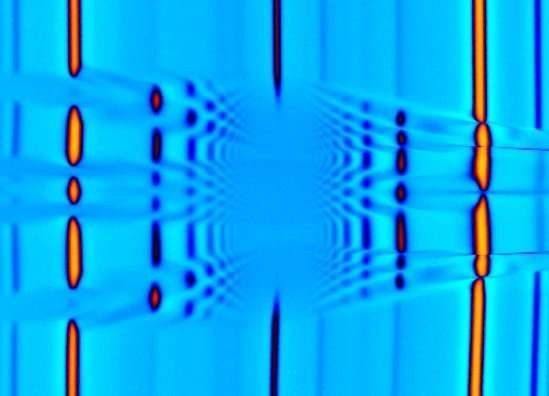Quantum Computing: Graphene-Based Device Theoretically Proves Existence Of Non-Abelian Anyons

Researchers from University of California, Santa Barbara, have developed a device that could prove the existence of non-Abelian anyons. These 2-dimensional quantum particles were theorized and mathematically predicted to exist but have not been synthesized till now.
A study published in the journal Nature has taken the first steps toward finding conclusive evidence of the existence of non-Abelian anyons. The researchers used graphene, an atomically thin material derived from graphite, to develop “an extremely low-defect, highly tunable device in which non-Abelian anyons should be much more accessible,” said a news release published on the university website.
These anyons are a type of quasiparticle that occur only in two-dimensional systems, with properties much less restricted than those of fermions and bosons. Here, when the system undergoes degeneration by exchanging two identical particles, there will be a change in state but the particles themselves will retain the same configuration.
Anyons are generally classified as abelian or non-Abelian. Abelian anyons have been detected and play a major role in the fractional quantum Hall effect. Non-Abelian anyons have not been definitively detected, although this is an active area of research.
In a 3D world, elementary particles can either be fermions or bosons.
"The difference between these two types of 'quantum statistics' is fundamental to how matter behaves," physicist Andrea Young, author of the study said.
Several fermions cannot remain in the same quantum state. This allows us to push electrons (fermion) around in semiconductors given its unique properties and also helps prevent neutron stars from collapsing, Young added. But bosons can occupy the same state and this property gives rise to pre-existing principles in physics known as the Bose-Einstein condensation and superconductivity.
According to the team, if a few fermions (protons, neutrons and electrons in atoms) are combined, you can get either type but never evade the dichotomy. This means we can give combined fermions one particular charge but a contrast between opposite charges in inevitable.
When the same laws are applied to a two-dimensional system, the laws of physics allow for a third possibility. This possibility was termed "anyons." These quantum particles cannot be classified as boson or fermion.
There are several types of anyons. Non-Abelian anyons are those that can retain memory of their past states. This will help encode quantum information across long distances. They could be used to form the building blocks for data sharing and storing in topological quantum computers.
Electrons can exist in a two-dimensional state when arranged in a very thin sheet or slab. When this happens, we can eject anyons as "quasiparticles" from the correlated states of many electrons in the sheet. When an electric potential is applied to the system, the entire system rearranges just as if an anyon had moved.
The team plans on looking into the quantum Hall effect to help identify non-Abelian anyons.
"In fractional quantum Hall states — a type of collective electron state observed only in two dimensional samples at very high magnetic fields — the quasiparticles are known to have precisely a rational fraction of the electron charge, implying that they are anyons," Young said in the release.
"Mathematically, sure, non-Abelian statistics are allowed and even predicted for some fractional quantum Hall states," he added.
The major limitation has been the fragility of the host states in the semiconductor material where they are typically studied. These anyons can only be studied when these materials are at exceptionally low temperatures and this makes it difficult to explore the unique quantum properties of individual anyons in this temperature.
But the team thinks graphene holds the solution to observing an isolated non-Abelian anyon. Graphene proves to be an ideal material to build devices to search for the elusive anyons. But, other materials surrounding the graphene sheet like the glass substrates and metallic gates introduced enough disorder to destroy any signatures of non-Abelian states, graduate student Sasha Zibrov, who assisted with the study, explained. The graphene is fine, the environment is the problem, he said.
"We've finally reached a point where everything in the device is made out of two-dimensional single crystals," said Young. "So not only the graphene itself, but the dielectrics are single crystals of hexagonal boron nitride that are flat and perfect and the gates are single crystals of graphite which are flat and perfect."
The flat and perfect crystals of material stacked on top of each other helped the team get a very low-disorder, extremely tunable system.
"Besides realizing these states, we can tune microscopic parameters in a very well controlled way and understand what makes these states stable and what destabilizes them," Young said.
The control this gave them helped the team theoretically prove the existence of non-Abelian systems.
Non-Abelian systems, studied under a more convenient temperature range, give us a minute understanding of the flow of energy in quantum systems. Developing a topological quantum bit has been a long-term dream for man and non-Abelian systems could provide the answer. Non-Abelian anyons are special as they are thought to be able to process and store quantum information independent of many environmental effects, a major challenge in realizing quantum computers with traditional means.
"Our experiments so far are consistent with theory, which tells us that some of the states we observed should be non-Abelian, but we still don't have an experimental smoking gun.
"We'd like an experiment that actually demonstrates a phenomenon unique to non-Abelian statistics," said Young, "now that we have a material that we understand really well, there are many ways to do this — we'll see if nature cooperates!"
© Copyright IBTimes 2024. All rights reserved.




















